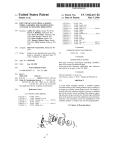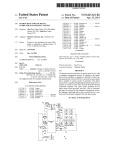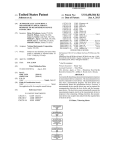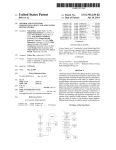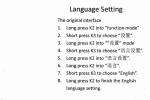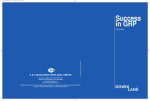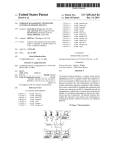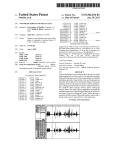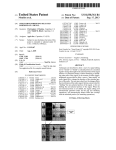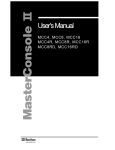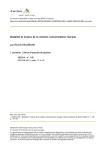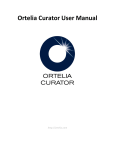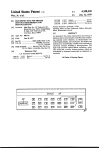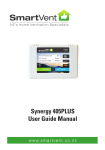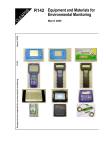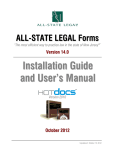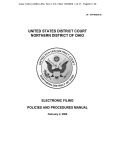Download Option menu for use with a computer management system
Transcript
USOO8749481B2 (12) United States Patent (10) Patent No.: Lee et a]. (54) (45) Date of Patent: OPTION MENU FOR USE WITH A 5,721,842 A COMPUTER MANAGEMENT SYSTEM 5,732,212 A 5,821,918 A (75) Inventors: Alex Lee, Taipei Hsien (TW); Yee LiaW, Wareen, NJ (US); Alan Hsu, Taipei Hsien (TW) 5,884,096 A 5,913,034 A 5,937,176 A 5,978,389 A - _ - - 6,112,264 A (73) A551gnee. gingtan Americas, Inc., Somerset, NJ 6,119,148 A 6,138,191 A ( * ) Notice: A 1 N . Jun. 10, 2014 2/ 1998 Beasley 3/1998 PerholtZ 10/1998 Reinert et a1. 3/1999 Beagley 61999 Malconn 8/1999 Beasley 11/1999 Chen 8/2000 Beasley 9/2000 Chen 10/2000 Fujii et al. Subject to any disclaimer, the term of this 3:323 et 31 patent is extended or adjusted under 35 (21) US 8,749,481 B2 6,505,245 B1 100% North et al‘ U-S~C~ 154(b)by 820 days~ 6,554,709 B1 * 4/2003 Brenner etal. ............... .. 463/42 12/110 797 6,557,170 B1* 4/2003 Wilder et a1. ............... .. 725/130 0.: pp ’ (22) Filed: (Continued) Apr. 28, 2008 OTHER PUBLICATIONS (65) Prior Publication Data Trial Transcript, Apex v. Raritan, Southern District of New York, US 2008/0244662 A1 (62) (51) Oct. 2, 2008 Case NO'01_CV_4435,V01‘1151112002, Related US. Application Data (Continued) Division of application No. 10/734,602, ?led on Dec. 12, 2003, noW Pat. No. 8,427,421. Primary Examiner i Lun_Yi Lao Int, Cl, Assistant Examiner * Shaheda Abdin G09G 5/00 (52) US. Cl. (2006.01) USPC .......... .. 345/156; 345/157; 345/1.1; 345/204; 58 F M f Cl ( ) UISPCO _? _ (57) ABSTRACT 5 3451/1589; 715/856; 715/810 Amethod for improving video quality of a video stream. The as“ ugxg/ll leafcs 2 0 4 80 87 156 157 """""" 5689' 7’15'/7’71 8’5 6 T81 7137201f ’ ’700283 7’25/37i38’ method decodes the video stream and generates subblocks of video data from the video stream. The method then removes effects of subblock boundaries from previous deblocking. See application ?le for complete search history Each subblock is then smoothed to create pixel values and ' (56) optionally, subblocks are merged if a predetermined quality is References Cited not achieved from the smoothing analysis. The pixels values U.S. PATENT DOCUMENTS blocks are deblocked and then at least one subblock is out are ?lled into each pixel position in the subblock. The sub 5,257,390 A 5,268,676 A 5,353,409 A 10/1993 Asprey 12/1993 Asprey et al. 10/1994 Asprey et al. 5,526,024 A * 6/1996 Gaglianello et a1. ........ .. 345/547 5,648,795 A 7/1997 Vouriet al. putted to a rendering device. 10 Claims, 11 Drawing Sheets US 8,749,481 B2 Page 2 (56) References Cited U.S. PATENT DOCUMENTS Defendant Raritan Computer, Inc.’s Supplemental Response to Plaintiffs Second Set of Interrogatories (Nos. 9-12), Dec. 12, 2001. DEI, Central Control of Multiple PCs Without Massive Cabling, product brochure, Nov. 1992. 6,671,756 B1 12/2003 Thomas et al. Expert Report by Joseph C. McAlexander Regarding Infringement 6,768,501 B2 6,771,213 B2 7,310,775 B2 7/2004 Kitagawa et al. 8/2004 Durst 12/2007 Cooper et a1. andValidity ofU.S. Patent Nos. 5,884,096, 5,937,176 and 6,112,264, 7,512,906 B1* 2003/0035006 A1 2004/0131340 A1 3/2009 Baier et al. .................. .. 715/866 2/2003 Kodosky et al. 7/ 2004 Antoun et a1. Jan. 3, 2001. Expert Report by Joseph C. McAlexander Regarding Infringement andValidity ofU.S. Patent Nos. 5,884,096, 5,937,176 and 6,112,264, Jan. 3, 2001. Claim Charts. Expert Report of Michael H. Davis, Jan. 13, 2002. OTHER PUBLICATIONS Expert Report of Sharad Malik, Regarding Noninfringement and Tron International, Inc., KVM Products Catalogs, 1997. Tron International, Inc., Products Catalogs, 1996. Tron International, Inc., Product Brochure, 1997, 4 pages. Unisys, PW2 Advantage Series Rackmount Server, 1995. Yee Liaw Deposition Transcript, Case No. 01-CV-4435, Mar. 3, Invalidity of US. Patent Nos. 5,884,096, 5,937,176 and 6,112,264, Jan. 13, 2002. (Unexecuted). File History ofU.S. Patent No. 5,721,842, Feb. 24, 1998. File History ofU.S. Patent No. 5,732,212, Mar. 24, 1998. File History ofU.S. Patent No. 5,884,096, Mar. 16, 1999. File History ofU.S. Patent No. 5,937,176, Aug. 10, 1999. File History ofU.S. Patent No. 6,112,264, Aug. 29, 2000. File History ofReissue US. Patent No. 5,732,2 12, Apr. 11, 2002. Part 2005. Yee-Shung Liaw Deposition Transcript, Case No. 01-CV-4435, Dec. 6, 2001. The list of docket reports in the litigation: Avocent Redmond Corp. v. Raritan Computer, Inc., Civil Action No. 1:01-CV-04435(PKC), United States District Court for the Southern District of New York. Adder, Products Brochure, APX 304572-304579, Apr. 1, 1998, 8 pages. AdderViewOSD, Products Brochure, RCI 173246-173279, Aug. 1, 2002. Avocent’s Pre-Markman Hearing Memorandum in Support of its Proposed Claim Constructions (Dec. 15, 2004). Avocent Redmond’s Answering Pre-Markman Hearing Brie?ng (Jan. 18, 2005). 1. File History ofReissue US. Patent No. 5,732,2 12, Apr. 11, 2002. Part 2. File History ofU.S. Appl. No. 10/032,325, Jun. 14, 2004. Findings and Conclusions, Apex v. Raritan, Civil Action No. 01-CV 0035, Feb. 25, 2002. Investor’s Business Daily, Box Keeps Monitors, Mice to a Minimum, Sep. 8, 1997. Joseph C. McAlexander Deposition Transcript, Case No. 01-CV 4435, Apr. 27, 2005. KVM Switch History, Aug. 2, 2002, 2 pages. KVM Switches Roundup, Windows NT Magazine, Jul. 1997. Lan Times, The beauty of Apex is a two-sided story, Nov. 20, 1995. Apex et al, Products Brochure, APX 316564-316621. Apex et al, Products Brochure, APX 316848-316909. Apex et al, Products Brochure, APX 316910-316969. Apex, SwitchBack User Guide, 1995. Apex’s Motion on the PolyCon Catalog and Supporting Memoran dum, Jan. 15,2002. Apex’s Proposed Markman Findings, Jan. 25, 2002. Appendixl to Apex’s Proposed Markman Findings, Jan. 25, 2002. 304605, Jun. 1, 1998. Lu, E&J Int. 4-Port KVM Switch, Jul. 4, 2001. Marksman Transcript, Avocent v. Raritan, Civil Action No. 4435, Feb. 3, 2005. Marksman Transcript, Avocent v. Raritan, Civil Action No. 4435, Feb. 4, 2005. Badman, Switching into High Gear, Network Computing, Apr. 30, 4435, (Mar. 11,2005). Lightwave Communications, Inc., Product Brochure, APX 304594 Memorandum and Order on Marksman issues, Case No. 01-CV Bruce McNair Deposition Transcript, Case No. 01-CV-4435, May 5, Network Computing, Product Brochure, May 15, 1995, 5 pages. Network Technologies Inc., Product Brochure, 1998, 2 pages. Network World, advisement, Jul. 6, 1992. 2005. Ocean Isle, Reachout Product Brochure, RCI 172996-173006, Jun. 2001 . Belkin, The OmniView Pro User Manual, Jul. 16, 2001. Compaq, White papers, 1996, APX 083313-APX 083326, APX 1994. 083335-APX 083389. 2005. PC World, New Products, May 1995, 2 pages. PolyCon GmbH Data System Inc., product catalogs, APX 024328 042697, prior to Spring, 1995. Ching-I Hsu Deposition Transcript, Case No. 01-CV-4435, Mar. 11, Cybex, Director Installer/User Guide, Nov. 1996. Press Release, Maintain Error-Free Central Control of 128 PCs from Cybex, 4 x P & 1 x P KVM Switches Guide to Applications, 1996. One Set of Keyboard, Mouse, and Monitor, Feb. 4, 1999, 1 page. Datavision, Product Brochure, 1992, 3 pages. Declaration of Joseph C. McAlexander in Support of Apex’s Motion for a Preliminary Injunction, Sep. 17, 2001. Declaration of Joseph C. McAlexander, III in the Civil Action No. 01-CV-4435, Dec. 15, 2004. Declaration of Sharad Malik, Ph. D., Jan. 8, 2002. Declaration of Sharad Malik, Ph.D. (Jan. 18, 2005). Protest Under 37 CFR 1.291 Filed in US. Patent No. 08/969,723, Feb. 13, 1999. Defendant Raritan Computer Inc.’s Claim Construction Statement (Dec. 15,2004). Defendant Raritan Computer Inc.’s Motion for Partial Summary Judgment (Jan. 8, 2002). Defendant Raritan Computer Inc.’s Proposed Findings of Fact and Conclusions of Law, Apr. 27, 2005. Defendant Raritan Computer Inc.’s Reply to Avocent’s Proposed Raritan, CompuSwitch, Mar. 16, 1998, 1 page. Raritan, Dominion KSX, Jul. 19, 2003, RCI 139356-139371. Raritan, Dominion KX and Dominion KSX, 2004, 181193-181211. Raritan, MasterConsole MXU2, Jul. 31, 2001. Raritan, MasterConsole II, User’s Manual, 2000. Raritan, Paragon UMT2161, RCI 147483-147505, Jul. 5, 2002. Raritan, Paragon User’s Guide, Jun. 15, 2000. Raritan, Paragon II User Manual, 2004. Raritan, Products Brochure, 2004-2005, p. 185899-185912. Raritan, Product Introduction, Oct. 23, 2000. Rebuttal Expert Report of Joseph C. McAlexander Regarding Valid ity and Infringement of US Patent Nos. 5,884,096, 5,937,176 and Claim Constructions (Jan. 18, 2005). 6,112,264, Apr. 11,2005. Defendant Raritan Computer, Inc.’s Response to Plaintiffs Second Defendant Raritan Computer, Inc.’s Second Set of Interrogatories to Plaintiff Apex, Nov. 16, 2001. Rextron, Product Brochure, Aug. 1, 2002, 5 pages. Rose Electronics, “Master Switch Installation and Operation Manual,” 1991. Rose Electronics, UltraView Installation and Operation Manual, Defendant Raritan Computer, Inc.’s Supplemental Response to Plaintiffs First Set of Interrogatories (Nos. 9-12), Aug. 31, 2001. Rose Electronics, Ultra View, Aug. 1, 2002, RCI 173332-173336. Set of Interrogatories (Nos. 9-12), Oct. 30, 2001. 1991-1997. US 8,749,481 B2 Page 3 (56) References Cited OTHER PUBLICATIONS Startech Computer Products Ltd., Product Press Release, APX 304618-304619, Feb. 1998. Supplemental Expert Report of Bruce McNair Regarding United States Patent Nos. 5,884,096 & 6,112,264 and 5,937,176, Apr. 17, 2005. Supplemental Expert Report of Joseph C. McAlexander Regarding Infringement of US. Patent Nos. 5,884,096, 5,937,176 and 6,112,264, Mar. 22, 2005. Supplemental Expert Report of Michael H. Davis, Apr. 18, 2005. SwitchCom, ProServer, Aug. 1, 2002, 2 pages. Tikkler, Belkin OmniView SE 4-Port KVM Switch, Nov. 8, 2000. Tony Dekerf and Gary D. Davis, “A Close Look At Modern Key board, Video & Mouse Switches,” 1995. Trial Transcript, Apex v. Raritan, Southern District of New York, Case No. 01-CV-4435, vol. 1, Jan. 2002. Trial Transcript, Apex v. Raritan, Southern District of New York, Case No. 01-CV-4435, vol. 2, Jan. 2002. Trial Transcript, Apex v. Raritan, Southern District of New York, Case No. 01-CV-4435, vol. 3, Jan. 2002. Trial Transcript, Apex v. Raritan, Case No. 01-CV-4435, vol. 4, Jan. Trial Transcript, Apex v. Raritan, Case No. 01-CV-4435, vol. 5, Jan. Trial Transcript, Apex v. Raritan, Case No. 01-CV-4435, vol. 6, Jan. Southern District of New York, 2002. Southern District of New York, 2002. Southern District of New York, 2002. Apex, OutLook User Guide, Apr. 1997. Apex PC Solutions, Users Guide, Apr. 1993. Apex et al, Products Brochure, APX 316564-316621, prior to 1995. Apex et al, Products Brochure, APX 316848-316909, 1987-1998. Apex et al, Products Brochure, APX 316910-316969, 1983-1998. Avocent Redmond’s Supplemental Responses to Raritan’s Second Set ofPost-Remand Interrogatories (Nos. 15R-17R), Mar. 14, 2005. Apex, OutLook User Guide, 1997. Apex et al., Products Brochure, APX 082949-082971, 1996. Apex PC Solutions, Users Guide, 1993. Apex, Products Brochure, APX 018983-018996, Jan. 7, 1997. Apex, Products Brochure, APX 019103-019121, 1995-1996. Apex, Products Brochure, APX 056304-056346, Oct. 1, 1998. Apex’s Sales Brochure, Sep. 1, 1998, 1 page. Of?ce Actions mailed on Sep. 9, 2011 and Jul. 11, 2012 in related U.S. Appl. No. 12/110,763. * cited by examiner US. Patent Jun. 10, 2014 Sheet 1 0f 11 US 8,749,481 B2 US. Patent Jun. 10, 2014 Sheet 2 0f 11 .5: 2% mom #55I. 9:5: won 82, as? in 1| :25:0 M386 F, n 83> E32 US 8,749,481 B2 US. Patent Jun. 10, 2014 599 Sheet 3 0f 11 US 8,749,481 B2 (Option) 14.513 MHZ 394 --—-P H s c P“- CI k 0C J—> Buffer —Z/n_’ E 362 — 396 -——592 390 $121: Ir- ---------------- "-1 PM “i: | T a“ H. 393 5 378 1 (572 M M: E : : E E 1'»5_4 E I I System Level IC inc—v" @ 5W 384 582 --: Saw __ 059 MM HEB 354 ) DVA E (outline) E (Body) : 1 %7_-§‘£'§°rl'“189_93_0_ £C§__J v 5)“ ‘— l 4——H| "5 i : L.“22:9":=;°:_"E¢22_°§9-19§J 4—;4 MHZ m RGB 386 : r——— —————————————— "q \ H 5m ) i l l m H Syn; : | _: 580 Connector E 1&9 a 4 363 RGB \ 370 \ — 31B 553 FIG. 28 US. Patent Jun. 10, 2014 6100 Red Green/ H Sync 61 00 / BSynclue/V Fl-L_ _I4 Sheet 4 or 11 US 8,749,481 B2 US. Patent Jun. 10, 2014 Sheet 5 0f 11 US 8,749,481 B2 W m MODE A: 252, 144 COLORS MODE B: 512 COLORS l l - l I - l_—.__....l MODE C: 8 COLORS MODE O: 8 COLORS FIG. 3 US. Patent Jun. 10, 2014 US 8,749,481 B2 Sheet 6 0f 11 $ng § 3%. MJ mm 5. 0 CNN)p 0 o 0 =2 h OIU+ ‘ ? k Iw w m +Nu“) Am 0mm8“ gm?m 83.52%>:5 US. Patent Jun. 10, 2014 Sheet 7 0f 11 .52: a » @% US 8,749,481 B2 QH \ am: mm H .F OI: h, I :8 Eu % %dil mz 5823>5 Q H “L2B0E:8S 50:|3I2. .OEm US. Patent Jun. 10, 2014 Sheet 8 0f 11 US 8,749,481 B2 U.S. Patent Jun. 10, 2014 Sheet 9 0f 11 CO ,— IF Hm olmw lW o: US 8,749,481 B2 US. Patent Jun.10,2014 an Sheet100f11 IG no“. IOQ ~12. .‘C aIn. mow a ono“ 0 no“ mmw o a o a +|l\@oh US 8,749,481 B2 US. Patent Jun. 10, 2014 Sheet 11 0111 US 8,749,481 B2 Connected Connected Connected w w w Computer Computer 818 ‘ Computer 818‘1 w B1B\_I m 830 a §.1_6 830 CPU 830 a CPU Q CPU E N f I 832 E 832 _ I f 832 V I d-—--— Smtchlng Devlce ' % “' Siitch CPU 826 Video @ Switch q v I @ ‘7 i |o§| |81_v| 1.1.; Mood 002 Cu'sor ' ' W m, Moe B]! m FIG. 9 I v m 8.0.8 Client Keybwd m, M 1m we Moe 804 US 8,749,481 B2 1 2 OPTION MENU FOR USE WITH A COMPUTER MANAGEMENT SYSTEM between the system administrator’s user console and remote computer equipment is often not a feasible alternative. Space is also an important concern for many networked CROSS-REFERENCE TO RELATED APPLICATIONS computer environments, especially large-scale operations This application is a divisional of application Ser. No. 10/734,602, ?led on Dec. 12, 2003, now US. Pat. No. 8,427, 421 issued onApr. 23, 2013, entitled “OPTION MENU FOR USE WITH A COMPUTER MANAGEMENT SYSTEM,” house a keyboard, video monitor, and cursor control device such as data-centers, server-farms, web-hosting facilities, and call-centers. These environments typically require space to for each piece of computer equipment and for all of the wiring required to connect and power these components. As more equipment is added to a computer network, it becomes more probable that the space required for the equipment and asso ciated cabling will exceed the space allotted for the network. which is incorporated herein by reference. This application also relates to co-pending US. patent application Ser. No. 12/110,763, ?led on Apr. 28, 2008, now abandoned, entitled Therefore, network architecture, equipment size, and avail able space are important issues when designing an effective “OPTION MENU FOR USE WITH A COMPUTER MAN AGEMENT SYSTEM.” FIELD OF THE INVENTION The present invention relates generally to an option menu for use with a computer management system. Speci?cally, the enhanced video display of the present invention combines or 20 computer network environment. One method of reducing the amount of space required to house a computer network is to eliminate any equipment (i.e., keyboard, video monitor, cursor control device, etc.) that is not essential for proper operation of the computer network. Elimination of this equipment also eliminates the wiring associated with such equipment. This equipment and its asso ciated wiring may be eliminated if a system administrator is organizes multiple video signals to provide a single option able to access the remote computers from one user console, menu video display having more colors, more characters, and/ or a larger size than traditional option menus. Although the present invention may be utilized in many applications, it is described herein to create an option menu that is incorpo rated within a computer/ server management system. That is, the enhanced video display provides a menu of options (e. g., computers connected to the management system, video dis thereby eliminating the dedicated equipment and its associ ated wiring. Elimination of this unnecessary equipment 25 decreases the amount of space required for computer network environments. A keyboard, video monitor, and mouse (“KVM”) switch ing system may be utilized to allow one or more user work 30 stations to select and control any one of a plurality of remote play adjustment settings, diagnostics, etc.) that is displayed computers via a central switching unit. Such systems are well on a system user’s monitor. The system user then responds to known in the art and have been used by system administrators for at least 10 years. Speci?cally, a KVM switching system the option menu (i.e., makes a selection) via the user’s key board and/or cursor control device. 35 BACKGROUND OF THE INVENTION In a typical computer environment, a Local Area Network (LAN) allows for one or more computer servers to be con nected to several computers such that the resources of each server are available to each of the connected computers. In this system, a dedicated keyboard, video monitor, and cursor control device may be employed for each computer and com 40 methods known in the art. For example, the computer man agement system component can include an array of buttons where each button corresponds with the desired remote com puter server. To maintain proper operation of the LAN, the system allows a system user to control a remote computer using a local user workstation’ s keyboard, video monitor, and cursor control device as if these local devices were directly con nected to the remote computer. In this manner, a system user may access and control a plurality of remote computers, such as servers, from a single location (i.e., the location of the user workstation). The system user may select a speci?c remote computer to access or control using any one of a variety of 45 puter. Alternatively, a user can select the computer from a list displayed on a computer management system component’s administrator must maintain and monitor the individual serv ers and computers. This maintenance frequently requires the LCD or LED display, press one or more hot keys on the local system administrator to perform numerous tasks from the user workstation’s keyboard (e.g., F1, ALT-F1, F2, etc.), user console located at each server or computer. For example, to reboot a computer or to add or delete ?les, the system administrator is often required to operate the server or com puter from its local user console, which may be located at a substantial distance from the system administrator’s com puter. Therefore, to accomplish the task of system adminis tration, the system administrator must often travel far dis select the remote computer from a list displayed on the user 50 etc. The following references, which are discussed below, were found to relate to the ?eld of computer management systems: 55 tances to access the local user consoles of remotely located servers and computers. As an alternative, dedicated cables may be installed from each remotely located server and computer to the system administrator’s user console to allow the system administra 60 mitted signal often results. Thus, utilizing dedicated cables holtz et al. US. Pat. No. 5,732,212 (“Perholtz”), Chen US. Pat. No. 5,978,389 (“Chen ’389 patent”), Chen US. Pat. No. 6,119,148 (“Chen ’ 148 patent”), Fujii et al. US. Pat. No. sley”), and Wilder et al. US. Pat. No. 6,557,170 (“Wilder”). ing and wire harnessing, both of which may require equipment increases, a decrease in the quality of the trans Asprey US. Pat. No. 5,257,390 (“Asprey ’390 patent”), Asprey US. Pat. No. 5,268,676 (“Asprey ’676 patent”), Asprey US. Pat. No. 5,353,409 (“Asprey ’409 patent), Per 6,138,191 (“Fujii”), Beasley US. Pat. No. 6,345,323 (“Bea tor to fully access and operate the remote computer equip ment. However, such an alternative requires substantial wir tremendous cost. Additionally, as the distance between the system administrator’ s user console and the remote computer workstation’ s monitor by pointing to it or scrolling to it using the user workstation’s keyboard and/or cursor control device, 65 TheAsprey ’390 patent, ?led on Jul. 26, 1991 and issued on Oct. 26, 1993, discloses an extended range communications link for coupling a computer to a mouse, keyboard, and/or video monitor located remotely from the computer. The end of the link that is coupled to the computer has a ?rst signal US 8,749,481 B2 3 4 conditioning network (i.e., a network of circuitry that damp tion may be connected either via the Public Switched Tele ens the ringing and re?ections of the video signals and biases them to a predetermined voltage level) that conditions the keyboard, video monitor and mouse signals. Conditioning the phone System (“PSTN”) and modems or via direct cabling. The Chen ’389 patent, ?led on Mar. 12, 1998 and issued on Nov. 2, 1999, discloses a device for multiplexing the video output of a plurality of computers to a single video monitor. The system includes three sets of switches for receiving the red, green, and blue components of the video signals from each computer. To select the video output of a speci?c com puter for display on the video monitor, a user inputs two video video monitor signals includes reducing their amplitude in order to minimize the “crosstalk” induced on the conductors adjacent to the video signal conductors during transmission of the video signals. This ?rst signal conditioning network is coupled to an extended range cable having a plurality of conductors that transmits the conditioned signals, power, and selecting signals into a control signal generating circuit. Depending upon the inputted video selecting signals, the control signal generating circuit produces an output signal logic ground potentials to a second signal conditioning net work (i.e., a network of circuitry that terminates the video signals using a voltage divider and ampli?es them), which corresponding to the selected video output. Thereafter, a con restores the video signals to their original amplitude and trol signal is generated that indexes the three sets of switches to switch the video signals being output by the desired com puter to the single video monitor. The three sets of switches transfer the incoming video signals to three sets of switch circuits and current amplifying circuits that provide input and outputs them to a video monitor. The Asprey ’ 676 patent, ?led on Mar. 5, 1990 and issued on Dec. 7, 1993, discloses a communications link for use between a computer and a display unit, such as a video moni tor, that allows these two components to be located up to three hundred (300) feet apart. An encoder located at the computer end of the communications link receives analog red, green, and blue signals from the computer and inputs each signal to a discrete current ampli?er that modulates the signal current. output impedance matching, respectively. The tuned video 20 The Chen ’148 patent, ?led on Jul. 29, 1998 and issued on Sep. 12, 2000, discloses a video signal distributor that receives, processes, and distributes video signals received Impedance matching networks then match the impedance of the red, green and blue signals to the impedance of the cable and transmit the signals to discrete emitter-follower transis from one or more computers to a plurality of video monitors. 25 these signals are ampli?ed prior to inputting them to the video monitor. Concurrently, the horizontal synchronization signal 30 matched to the impedance of the cable, thereby allowing the conductor to attenuate the horizontal synchronization signal and reduce noise radiation. TheAsprey ’409 patent, ?led on Jul. 19, 1990 and issued on Oct. 4, 1994, discloses an extended range communications The video signal distributor includes three transistor-based, voltage-amplifying circuits to individually amplify the red, tors located at the video monitor end of the cable. Thereafter, is inputted to a cable conductor and its impedance is not signals are then displayed on the single video monitor. green and blue video signals received from each computer prior to transmitting these signals to a video monitor. The video signal distributor also includes a synchronization signal buffering device that receives horizontal and vertical syn chronization signals from each computer and generates new synchronization signals based upon the quantity of video 35 link for transmitting transistor-transistor logic video signals signals that are output to the video monitors. Fujii, ?led on Feb. 10, 1998 and issued on Oct. 24, 2000, discloses a system for selectively operating a plurality of computers that are connected to one common video monitor. from a local computer to a video monitor located up to a The Fujii system includes a data input device for entering data thousand feet (1,000) from the computer. The link includes a ?rst signal conditioning circuit (i.e., a circuit that reduces the amplitude of the video signals, biases them to a selected potential, and applies them to discrete conductors of an extended cable) located at the computer end of the link for in any one of the plurality of connected computers. The sys tem also includes a main control circuit, which is connected to the data input device, and a selection circuit for providing the 40 entered data and receiving the video signals from the selected conditioning the received signals and transmitting them via the extended cable to a second signal conditioning circuit. The second signal conditioning circuit (i.e., a circuit that 45 utilizes a threshold or pair of thresholds to effect reconstruc tion of the video signals prior to applying the signals to a video monitor) receives the transmitted video signals prior to inputting them to the video monitor. According to the Asprey ’409 patent, performance of this process reduces the appear ance of high frequency video noise on the keyboard clock computer. A user selects a remote computer by supplying the command code associated with the desired remote computer utilizing the keyboard and/or mouse. A selection circuit receives the inputted commands and identi?es the selected computer. The selection circuit then sends a signal indicative of the selected remote computer to a main control circuit, which provides communication between the keyboard, video 50 monitor, and mouse and the selected remote computer. Similar to Perholtz, Beasley, ?led on Jun. 9, 2000 and issued on Feb. 5, 2002, discloses a speci?c implementation of conductor of the transmission cable, thereby preventing key a computerized switching system for coupling a local key board errors. board, mouse and/or video monitor to one of a plurality of Perholtz, ?led on Jan. 13, 1994 and issued on Mar. 24, 1998, discloses a method and apparatus for coupling a local user workstation, including a keyboard, mouse, and/ or video monitor, to a remote computer. Perholtz discloses a system remote computers. In particular, a ?rst signal conditioning 55 a list of connected remote computers on the local video moni tor. To activate the menu, a user depresses, for example, the “print screen” key on the local keyboard. The user selects the desired computer from the list using the local keyboard and/or wherein the remote computer is selected from a menu dis played on a standard size personal computer video monitor. Upon selection of a remote computer by the system user, the remote computer’s video signals are transmitted to the local 60 mouse. According to Beasley, the on-screen programming circuit requires at least two sets of tri-state buffers, a single on-screen processor, an internal synchronization generator, a synchro user workstation’s video monitor. The system user may also control the remote computer utilizing the local user worksta tion’s keyboard and monitor. The Perholtz system is also capable of bi-directionally transmitting mouse and keyboard signals between the local user workstation and the remote computer. The remote computer and the local user worksta unit includes an on-screen programming circuit that displays 65 nization switch, a synchronizationpolarizer, and overlay con trol logic. The ?rst set of tri-state buffers couples the red, green, and blue components of the video signals received from the remote computer to the video monitor. That is, when US 8,749,481 B2 5 6 the ?rst set of tri-state buffers are energized, the red, green, and blue video signals are passed from the remote computer to the local video monitor through the tri-state buffers. When the ?rst set of tri-state buffers are not active, the video signals from the remote computer are blocked. Similarly, the second set of tri-state buffers couples the outputs of the single on board and mouse to select and control the power supply of the desired remote computer. Wilder incorporates a single on screen processor for generation of the list of remote comput ers. In view of the foregoing, a need clearly exists for a com screen processor to the video monitor. When the second set of tri-state buffers is energized, the video output of the on- screen puter management system that is compatible with both stan dard size video monitors (e. g., monitors ranging from 13" to 21") and larger than standard size video monitors. In addition, programming circuit is displayed on the local video monitor. When the second set of tri-state buffers is not active, the video output from the on-screen programming circuit is blocked. Alternatively, if both sets of tri-state buffers are energized, the remote computer video signals are combined with the video provides an option menu that contains more characters and/or more colors than those available with a single on-screen pro cessor. There is also a need for a computer management a need clearly exists for a computer management system that signals generated by the on-screen processor prior to display system having an option menu that provides greater ?exibility and de?nition for identifying options and connected comput on the local video monitor. ers. Furthermore, there is a need for a computer management The on-screen programming circuit disclosed in Beasley also produces its own horizontal and vertical synchronization signals. To dictate which characters are displayed on the of available colors, which may be used to color code con nected computers or options for purposes such as identifying video monitor, the CPU sends instructional data to the on the general location of each connected computer (e.g., con system that provides an option menu having a large quantity screen processor. This causes the on-screen processor to 20 nected computers having a blue description are located in retrieve characters from an internal video RAM for display on the local video monitor. Quadrant 1, connected computers having a green description are located in Quadrant 2, etc.). Furthermore, there exists a need for a computer management system that provides an option menu that allows the system user to choose the desired The overlaid video image produced by the on-screen pro cessor, namely a Motorola MCl41543 on-screen processor, is limited to the size and quantity of colors and characters that 25 are available with the single on-screen processor. In other mode of operation (e.g., larger video display, more colors, words, the Beasley system is designed to produce an overlaid more characters, etc.). Also, a need exists for a computer management system that provides an option menu that allows video that is sized for a standard size computer monitor (i.e., not a wall-size or multiple monitor type video display) and is the system user to choose the size of the video monitor that is limited to the quantity of colors and characters provided by connected to the local user workstation. 30 SUMMARY OF THE INVENTION the single on-screen processor. During operation of the Beasley system, a remote com puter is chosen from the overlaid video display. Thereafter, the ?rst signal conditioning unit receives keyboard and mouse signals from the local keyboard and mouse and generates a data packet for transmission to a central cross point switch. The cross point switch routes the data packet to the second It is often convenient to control one or more connected 35 majority of computers in use today incorporate or are designed to be compatible with commonly known and used computer technologies (e.g., IBM, Apple, Sun, etc.), many signal conditioning unit, which is coupled to the selected remote computer. The second signal conditioning unit then routes the keyboard and mouse command signals to the key computers use identical or similar electrical connectors to 40 board and mouse connectors of the remote computer. Simi larly, video signals produced by the remote computer are routed from the remote computer through the second signal conditioning unit, the cross point switch, and the ?rst signal conditioning unit to the local video monitor. The horizontal and vertical synchronization video signals received from the computers from one local set of peripheral devices (i.e., key board, video monitor, cursor control device, etc.). Since the 45 connect peripheral devices. Also, a computer typically con tains a dedicated electrical connector for each type of periph eral device to which the computer is connected. Generally, the cables that connect such peripheral devices to the respective electrical connector are approximately six (6) feet in length, thereby limiting the distance from the computer at which the peripheral devices may be located. Alternatively, the devices remote computer are encoded on one of the red, green or blue may communicate wirelessly, however, the wireless signal video signals. This encoding reduces the quantity of cables similarly degrades as distance between the computer and the devices increases. In many circumstances, it is desirable to separate the peripheral devices from the computer due to space con straints. However, one skilled in the art may readily appreci required to transmit the video signals from the remote com puter to the local video monitor. 50 Wilder, ?led on May 5, 1998 and issued on Apr. 29, 2003, discloses a keyboard, video monitor, mouser and power (“KVMP”) switching system having an on screen display circuit that provides a visual means for accessing the KVMP switch. A ?rst set of switching circuits coupled to a plurality 55 of computers and the on screen display circuit allows a user to access and control any of the remote computers using a local keyboard, video monitor, and mouse. A second set of switch ing circuits coupled to the power supply of each remote ate that separating a computer from its peripheral devices by substantial distances is likely to increase cabling costs. In addition, signals such as cursor control device, keyboard, video, or audio signals degrade when transmitted over dis tances greater than ?fteen (15) feet resulting in decreased reliability of keyboard and cursor control device commands, and lower quality video and audio output. This degradation computer and the on screen display circuit allows a user to 60 occurs for a few reasons including the induction of “noise”, control the electrical power to each remote computer. To select a remote computer using the Wilder system, a user such as “crosstalk”, between adjacent conductors and an increase in the impedance of the signal transmission. activates the on-screen display by entering a “hot key” with either the keyboard and/ or mouse. Initially, the on-screen display prompts the user to enter a username and password. After the user is veri?ed, the user is provided a list of all attached remote computers. The user utilizes the local key 65 In addition to extending the distance between a computer and its peripheral devices, it is also convenient to access and operate more than one computer from a single set of periph eral devices. Again, this feature is desirable when space is limited, or when a large number of computers need to be US 8,749,481 B2 8 7 A variety of cabling mechanisms may be used to connect administered. The use of only one set of peripheral devices to control multiple computers eliminates the space required to the local user workstations and the connected computers to house a dedicated set of peripheral devices for each computer to be accessed and controlled. Furthermore, an increase in maintenance ef?ciency is realized if a system administrator can maintain multiple computers from a single set of periph eral devices. For example, the system administrator no longer must travel to each computer that requires maintenance. the computer management system of the present invention. Preferably, the present invention incorporates a single Cat The present invention provides a computer management system having an option menu that facilitates accessing and controlling connected computers. This option menu allows, the computer management system of the present invention) egory 5 Universal Twisted Pair (“CAT 5”) cable to connect each user terminal (“UST”)(i.e., the computer management system component that connects the keyboard, video moni tor, and cursor control device of the local user workstation to and each computer interface module (“CIM”)(i.e., the com puter management system component that connects the con nected computer to the computer management system of the for example, a system administrator to select a connected computer, enter video signal tuning calibration information, gather network diagnostics, program computer management present invention) to the matrix switching unit (“MSU”) of the computer management system of the present invention. system components, etc. The option menu is activated by entering predetermined keyboard and/or cursor control device commands. Upon choosing the option of selecting a connected computer, a sub-menu of connected computers is used without departing from the spirit of the present inven displayed on the user workstation’s monitor that includes all However, other cabling or wireless communications may be tion. Therefore, it is an object of the present invention to provide an improved computer management system containing an 20 connected computers. The system administrator may then option menu that may be larger and/or contain more colors scroll the sub-menu or access a further sub-menu to select the and characters than is standardly available. Further, it is an object of the present invention to provide an desired connected computer. The option menu of the computer management system of the present invention can have a larger overall size (i.e., it is menu that operates in any one of multiple modes, wherein the modes of operation allow a system user to select the size, improved computer management system having an option 25 visible on a larger screen) and/or contain more colors and quantity of characters, and quantity of colors for the option more characters than the typical video display provided by a menu based upon the user’s preferences and/ or the size of the video monitor connected to the local user workstation. single on-screen display integrated circuit (“OSD IC”). The option menu of the present invention is compatible with both standard size video monitors (e.g., monitors ranging from 13" to 21" in size) and larger monitors. Monitor size is simply selected by the system user via the option menu. In addition, the larger quantity of available characters and/or colors pro vides greater ?exibility and de?nition in identifying options and in identifying and selecting connected computers. 30 Furthermore, it is an object of the present invention to facilitate identi?cation of each computer connected to the computer management system by allowing information tech nology (“IT”) personnel to designate lengthier names dis 35 The option menu is generated by a plurality of OSD ICs. played in the option menu for each connected computer to more adequately describe each connected computer. It is still a further object of the present invention to provide greater organizational ?exibility by allowing IT personnel to The video outputs of the OSD ICs can be combined or stra color code computer names displayed in the option menu to tegically organized to produce an option menu having a larger facilitate grouping of computers connected to the computer size, more colors, and/ or a greater number of characters than is possible with a single OSD IC. In the preferred embodi management system. 40 ment, a ?rst set of OSD ICs is utilized to create the option menu, and a second set of OSD ICs is utilized to create a video image that represents the cursor. A software algorithm executed by a system level IC works in conjunction with minimal circuitry to combine and/or strategically organize 45 the video outputs of the ?rst and second sets of OSD ICs to provide the option menu and cursor video signals. The computer management system of the present invention may be utilized to provide compatibility between various operating systems and/or communication protocols. The BRIEF DESCRIPTION OF THE DRAWINGS 50 operating systems and protocols, including but not limited to, those manufactured by Microsoft Corporation (“Microsoft”) 55 A further understanding of the present invention can be obtained by reference to a preferred embodiment set forth in the illustrations of the accompanying drawings. Although the illustrated embodiment is merely exemplary of systems for carrying out the present invention, both the organization and method of operation of the invention, in general, together with further objectives and advantages thereof, may be more easily understood by reference to the drawings and the fol lowing description. The drawings are not intended to limit the scope of this invention, which is set forth with particularity in (“Compaq”) (Alpha), International Business Machines (“IBM”) (RS/6000), Hewlett-Packard Company (“HP”) (HP9000), and SGI (formerly “Silicon Graphics, Inc.”) apparent upon consideration of the following detailed description with reference to the accompanying drawings, all of which form a part of this speci?cation. present invention allows the same set of local peripheral devices to access connected computers executing a variety of (Windows), Apple Computer, Inc. (“Apple”) (Macintosh), Sun Microsystems, Inc. (“Sun”) (Unix), Digital Equipment Corporation (“DEC”), Compaq Computer Corporation Other objects, features, and characteristics of the present invention, as well as the methods of operation and functions of the related elements of the structure, and the combination of parts and economies of manufacture, will become more 60 the claims as appended or as subsequently amended, but (“IRIX”). merely to clarify and exemplify the invention Additionally, local devices such as a keyboard and cursor control device may communicate with the local user work For a more complete understanding of the present inven tion, reference is now made to the following drawings in which: station using a variety of protocols including, but not limited to Universal Serial Bus (“USB”), American Standard Code for information Interchange (“ASCII”), and Recommend Standard-232 (“RS-232”). 65 FIG. 1 is a schematic representation of a computer man agement system according to the preferred embodiment of the present invention illustrating the connection of a plurality US 8,749,481 B2 9 10 of user workstations, which each include a keyboard, video the present invention. Speci?cally, a modular, intelligent, computer management system is shown including a centrally located MSU 112, multiple USTs 108 connected to key monitor, and cursor control device, to multiple connected computers, wherein the system includes a plurality of USTs boards 102, video monitors 104, and cursor control devices 106, and multiple CIMs 116 connected to connected comput and CIMs interconnected by at least one MSU. FIG. 2A is a schematic representation of the preferred embodiment of the internal structure of the UST shown in ers 118. Each UST 108 and CIM 116 is connected to MSU 112 via communication link 110 and communication link FIG. 1, speci?cally illustrating the circuitry that allows for the selection of connected computer video signals or option 114, respectively. menu video signals for display on the video monitor. FIG. 2B is a schematic representation of the preferred embodiment of the option menu circuit shown in FIG. 2A, which generates the option menu and cursor video signals for display on the video monitor. FIG. 2C is a schematic representation of the preferred use with the present invention, other cabling may be used, such as coaxial, ?ber optic or multiple CAT 5 cables, depend ing on the speci?c needs of the system user. CAT 5 cabling is preferred because it reduces cabling cost while maintaining Although single CAT 5 cabling is the preferred cabling for the strength of the signals that are transmitted over extended distances. Additionally, the use of single CAT 5 cabling mini mizes the space required to house the computer system and its embodiment of the tuning circuit shown in FIG. 2A, which compensates for the amplitude and frequency reduction that occurs during video signal transmission. FIG. 3 is a schematic representation of the preferred embodiment of the four modes of operation of the option menu circuit shown in FIG. 2A and FIG. 2B. FIG. 4 is a schematic representation of the MSU shown in FIG. 1 according to the preferred embodiment of the present invention illustrating a block diagram of the internal structure of the MSU and electrical connectors for CAT 5 cables. FIG. 5 is a schematic representation of the preferred embodiment of the internal structure of the CIM shown in FIG. 1, illustrating the connection of the CIM to a connected associated wiring. Individual CAT 5 cables may be used for connection of each UST 108 and each CIM 116 to MSU 112. Conventional 20 these twisted pair are utilized for the transmission of video 25 30 con?guration of the computer management system for use with the present invention illustrating connection of multiple 35 40 user workstations and multiple connected computers to mul tiple MSUs, wherein the alternate embodiment may accom on the green video signal. All other non-video signals such as keyboard, cursor control device, and audio signals, are trans mitted on the fourth twisted pair cable. The single CAT 5 cables are connected to UST 108, MSU 112, and CIM 116 by plugging each end into a RJ-45 con nector located on these respective components. Although RJ-45 connectors are preferred, other types of connectors may be used, including but not limited to R] -1 1, RG-58, RG-59, British Naval Connector (“BNC”), and ST connec tors. As depicted in FIG. 1, the connected computer manage ment system includes local user workstations 100, each pref modate as many as sixty-four (64) user workstations and ten thousand (10,000) connected computers. FIG. 9 is a schematic representation of an alternate signals. That is, each synchronization signal is encoded on its own, dedicated color signal. For example, the vertical syn chronization signal may be encoded on the blue video signal while the horizontal synchronization signal may be encoded FIG. 7 is a schematic representation of an alternate con ?guration of the computer management system for use with the present invention illustrating connection of sixteen (16) user workstations and multiple connected computers to two MSUs, wherein the alternate embodiment may accommodate as many as thirty-two (32) connected computers. FIG. 8 is a schematic representation of another alternate signals. Each of the three (3) twisted pair transmits one of the three video color signals (i.e., red, green or blue). To allow all video signals to be transmitted via only three (3) twisted pair, the horizontal and vertical synchronization signals, which would otherwise each require their own twisted pair, are individually encoded on one of the red, green, or blue video computer and to an MSU. FIG. 6 is a schematic representation of a data packet used to transmit data in the computer management system accord ing to the preferred embodiment of the present invention. CAT 5 cables include four (4) twisted pair of wires. In the preferred embodiment of the present invention, three (3) of 45 erably comprising dedicated peripheral devices such as key board 102, video monitor 104, and/or cursor control device 106. Other peripheral devices may also be located at work station 100, such as printers, scanners, video camera biomet embodiment of the computer management system of the present invention, wherein the computer management system is contained in a single unit that is directly connected to all connected computers and user workstations. 50 DETAILED DESCRIPTION OF THE INVENTION ric scanning devices, microphones, etc. Each peripheral device is directly or indirectly (i.e., through another compo nent) connected to UST 108, which is attached to MSU 112 via communication link 110. Of course, wireless peripheral As required, a detailed illustrative embodiment of the devices may also be used with this system. During operation, present invention is disclosed herein. However, techniques, all electronic signals received at UST 108 from attached systems and operating structures in accordance with the present invention may be embodied in a wide variety of forms and modes, some of which may be quite different from those 55 in the disclosed embodiment. Consequently, the speci?c structural and functional details disclosed herein are merely representative, yet in that regard, they are deemed to afford 60 preferred computer management system in accordance with respective ports of connected computer 118. Each UST 108 incorporates the option menu circuit of the the best embodiment for purposes of disclosure and to pro vide a basis for the claims herein, which de?ne the scope of the present invention. The following presents a detailed description of the preferred embodiment (as well as some alternative embodiments) of the present invention. Referring ?rst to FIG. 1, depicted is the architecture of the peripheral devices are transmitted to MSU 112 via commu nication link 1 1 0. Thereafter, the signals are transmitted to the desired CIM 116 via another communication link 114. CIM 116, which is coupled to a connected computer 118 via com munication link 120, transmits the received signals to the 65 in accordance with the present invention that enables a user to access and control a connected computer via an option menu displayed on the local user workstation’s video monitor. For example, if a user wishes to connect to a speci?c connected computer 118, the user may ?rst enter a series of keyboard and/or cursor control device commands to cause UST 108 to US 8,749,481 B2 11 12 produce the option menu on video monitor 104. This option signal degradation). The tuned red, green, and blue compo menu, as discussed in detail below, lists all connected com puters 118. By utilizing keyboard 102 and cursor control nents of the video signals are transmitted to video switch 314. Thereafter, video switch 314 determines whether to transmit device 106, the user selects the desired connected computer the video signals received from tuning circuit 304 (i.e., the 118 from the option menu. The user is then provided access to video signals received from one of the connected computers 118) or the video signals received from option menu circuit the selected connected computer 118. The option menu also facilitates system programming and provides information useful for system operation. Furthermore, multiple security 318 to video ampli?er 316. Finally, the ampli?ed video sig nals are transmitted via video monitor port 312 for display on video monitor 104. Option menu circuit 318 is shown in greater detail in FIG. 2B. Preferably, option menu circuit 318, and all of its com ponents are implemented on a daughter board (i.e., a printed features such as passwords, system user histories, etc. may be implemented and operated in conjunction with the option menu. CIM 116 is compatible with all commonly used, present day computer operating systems and protocols, including, but circuit board that plugs into another printed circuit board to augment its capabilities). As shown, option menu circuit 318 comprises OSD ICs 350-357, system level IC 358, PLL 360, not limited to, those manufactured by Microsoft (Windows), Apple (Macintosh), Sun (Unix), DEC, Compaq (Alpha), IBM (RS/ 6000), HP (HP9000) and SGI (IRIX). Additionally, local devices such as keyboard 102 and cursor control device 106 clock buffer 362, digital to analog (“D/A”) converter 364, and may communicate with connected computers via a variety of connector 366. According to the preferred embodiment of the present invention, the option menu and cursor video displays protocols including Universal Serial Bus (“USB”), American Standard Code for Information Interchange (“ASCII”) and Recommend Standard-232 (“RS-232”). The computer management system of the present invention 20 Screen Display for LCD Monitor ICs, depicted in FIG. 2B as OSD ICs 350-357. However, a different quantity and/or a is scalable and may be con?gured to connect a large number of user workstations 100 with a large number of connected computers 118. Preferably, the system according to the present invention allows eight (8) USTs 108 and thirty-two 25 (32) CIMs to be connected via one MSU 112 while still mable logic controller IC, etc.) con?gured to produce the 30 thousand (10,000) connected computers 118. Turning next to FIG. 2A, depicted is a schematic diagram of the preferred internal structure of UST 108 according to the present invention. As shown, UST 108 couples keyboard 102, different type of OSD IC may be substituted without depart ing from the spirit of the present invention. Alternatively, an option menu circuit comprising individual electronic compo nents (e.g., logic gates, resistors, capacitors, etc.) or a com bination of non-OSD ICs (e.g., a processor IC, a program achieving optimal signal transmission. If additional USTs or CIMs must be added, alternate embodiments of the present invention allows multiple MSUs 112 to be utilized to connect as many as sixty-four (64) user workstations 100 and ten are generated by eight (8) Myson Technology MTV118 On 35 same output as OSD ICs 350-357 may be used to generate the option menu and cursor video displays. In the preferred embodiment of the present invention, each individual OSD IC is capable of producing eight (8) back ground colors, eight (8) foreground colors, and a video dis play having a maximum of ?fteen (15) rows by thirty (30) columns of characters, wherein each character comprises a 12 video monitor 104, and cursor control device 106 with MSU 112. Signals generated by keyboard 102 and cursor control by 18 pixel matrix. However, the present invention combines device 106 are received by UST CPU 308 via keyboard port 300 and cursor control device port 310, respectively, using the video signals generated by multiple OSD ICs to create a single option menu that is larger (i.e., contains more charac ters) and/or contains more colors than the display provided by industry standard connectors and cabling. Wireless key 40 an individual OSD IC. Preferably, OSD ICs 350-355 generate the non-cursor portion of the option menu in any one of four boards and cursor control devices may also be used. UST CPU 308 then generates data packets that represent the key board and cursor control device information in the received signals (as discussed below with reference to FIG. 6). The newly generated data packets are transmitted to UART 306, 45 whereupon the they are converted to a serial format and transmitted through port 302 to MSU 112 via independent communication link 1 10. It should be noted that the converted data packets may alternatively be transmitted via a wireless connection. 50 Conversely, keyboard and cursor control device signals received from connected computer 118 (FIG. 1) through (4) modesA-D, which are illustrated in FIG. 3. The remaining two (2) OSD ICs 356-357 generate the cursor video display used in conjunction with the option menu. As depicted in the upper left hand corner of FIG. 3, when the system of the present invention is indexed to Mode A, all six (6) OSD ICs 350-355 supply video to the same portionAl of a ?fteen (15) row by thirty (30) column video display. This con?guration allows the eight colors of each OSD IC 350-355 to be combined to produce a maximum of two hundred sixty two thousand one hundred forty four (262,144) colors. Each MSU 112 and communication link 110 are received as serial OSD IC is capable of supplying two (2) different green sig data packets at port 302. Thereafter, UART 306 de-serializes the received serial data packets and transmits them to UST nals, (2) different red signals, and (2) different blue signals, 55 CPU 308. Of course, in the alternative, a non-UART device may be used to de-serialize the received serial data packets. UST CPU 308 then uses the information contained in the data packets to emulate keyboard and cursor control device signals to keyboard. 102 and cursor control device 106 via keyboard port 300 and cursor control device port 310, respectively. Unidirectional video signals generated at connected com puter 118 (FIG. 1) are also received at port 302 from MSU 112 via communication link 110. However, these video signals are transmitted to tuning circuit 304, which tunes the video signals (discussed below with respect to FIG. 2C) to a desired amplitude and frequency characteristics (e.g., to correct for wherein the difference in the signals is a difference in the signal’ s color. Since the color of each pixel is the combination of the colors of the red, blue, and green signals that create the pixel, two (2) colors of red, green, and blue allow 2.sup.3, or eight (8), color combinations (i.e., pixel colors) to be created 60 by an individual OSD IC. Similarly, when each of the red, green, and blue signals of six OSD ICs 350-355 are com bined, 2.sup.6 (i.e., 64) colors of each of the red, green, and blue signals may be created. Since each pixel is a combination of any one of each of the sixty-four (64) red, green, and blue 65 signals, the total number of resulting pixel colors is 64.sup.3 (i.e., 262,144). Thus, in Mode A, the system of the present invention uniquely combines the outputs of six standard OSD


























